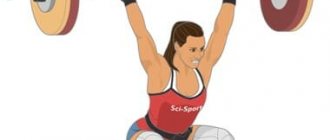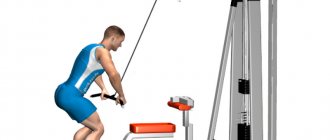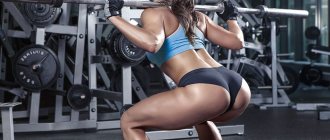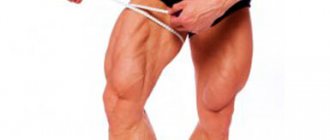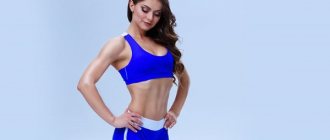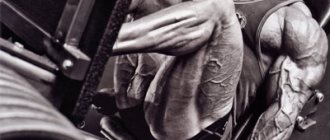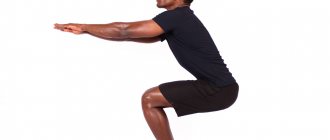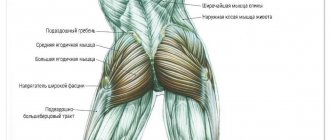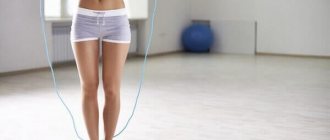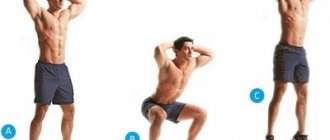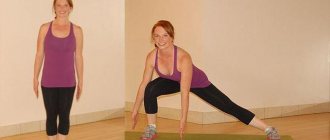An athletic, toned body and beautiful legs are the dream of every girl. By working out in the gym, you can achieve impressive results in a relatively short time.
A qualified trainer will tell you how to pump up a girl’s legs and select a set of effective exercises, taking into account individual characteristics and wishes.
Both at home and in the gym, girls have plenty of options for training their legs and keeping them in good shape.
Leg training for girls mainly includes exercises to work the back of the thigh and buttock muscles. Classes must be regular, at least twice a week. The load is increased gradually, in accordance with the level of physical fitness.
We also recommend that you pay attention to the article: Effective workouts for girls in the gym.
Important! Every leg workout for girls in the gym should begin with a warm-up. Simple aerobic movements prepare the body for stress and also reduce the risk of injury.
We also recommend studying this topic:
One of the effective comprehensive training programs in the gym
6559 0 1
Hyperextension
This exercise is a flexion and extension of the body, which allows you to thoroughly warm up and work the buttocks, thighs, and rectus dorsi muscles. Suitable as a warm-up before strength exercises.
Hyperextension machine
Hyperextension in the gym is performed on an extension bench. Hands are placed crosswise on the collarbones or on top of the head. At the point of maximum extension of the torso, you need to squeeze your buttocks for a few seconds. The head should not be thrown back; the back of the head should be at the same level as the spine. Performed smoothly without jerking, 12 bendings in 3 sets.
Readers found these materials useful:
- Exercises for calf muscles at home
- Effective leg training for weight in the gym
What should strength training be like?
Regardless of the program, every strength training begins with a warm-up. It must be done in the following order:
- Joint warm-up. Rotate the joints of your arms and legs 10 times in each direction, bend and turn your body and neck.
- 5-10 minutes of light cardio. Any suitable exercise machine will do: treadmill, stepper, ellipse, exercise bike. If everything is busy, jump rope.
In addition, before each exercise with a large weight, you need an additional warm-up with a small one. This will prepare the target muscles for work and protect you from injury. For example, if you are going to squat with a 50 kg barbell, do 5 reps with the bar, then 3 reps with 30 kg and 3 reps with 40 kg. Only then proceed to the main load.
Select the working weight so that the last repetitions of the approach are difficult, but without changing the technique: jerks, twisted back and unnecessary bends. If they appear, take lighter weights or reduce the number of repetitions.
Rest 60–90 seconds between sets and 1–2 minutes between exercises.
I strength training
Ab crunches
Works the abdominal muscles.
Lie on your back, place your feet on the floor, put your hands behind your head. Raise your body so that your shoulder blades lift off the floor and your lower back remains pressed. Do not put pressure on your head with your hands, your fingers only touch the back of your head, the movement is made by tensing the abdominal muscles, not the neck.
Perform 3 sets of 15–20 reps.
Hyperextension
Pumps up the back extensors, buttocks and back of the thigh.
Place your feet on the hyperextension machine and place your hands behind your head. Keeping your back straight, lower your body and then lift it up. At the top, look at the wall in front of you. Avoid jerking and sudden movements, perform the exercise smoothly and under control.
Do 3 sets of 15 reps. In the future, you can increase the number of repetitions to 20–25.
Back Squats
Loads the hips, buttocks and core muscles.
Place your feet slightly wider than straightened shoulders, bring your shoulder blades together, turn your toes slightly to the sides. Move your pelvis back, bend slightly at the lower back and inhale into a squat. Keep your back straight and look forward.
Squat until your thighs are parallel to the floor. If your heels don't come off, your knees don't curl inward, and your back remains straight, try squatting lower. If your back is rounded, return to the previous position, that is, again make your thighs parallel to the floor.
Exhale as you come out of the squat.
Start with a 15 or 20 kg bar and gradually increase the load. Keep an eye on your equipment at all times.
Block pull to the chest
Pumps up the back muscles.
Sit on a bench with your feet flat on the floor. Grab the handle with a straight (back) or reverse (biceps) grip. You can change them every week. Squeeze your shoulder blades, lower your shoulders, straighten your back. As you exhale, pull the handle until it touches your chest. The body does not lean back, the shoulders are lowered, the shoulder blades are brought together.
Return the pen and repeat the exercise.
Hip raises with barbell
Good load on the buttocks.
Prepare the barbell, sit next to the bench and place the bar on your feet. Lean your back on the bench, bend your knees, place your feet on the floor. Supporting the barbell with your hands, place it on your pelvis. Lift it off the floor, distribute the weight between the fulcrum on the bench and your feet on the floor.
By tensing the gluteal muscles, push your pelvis up until the hip joint is completely straightened. Lower yourself and repeat.
Bench press
Pumps up the pectoral muscles and triceps.
Lie down on a bench press with your feet flat on the floor. Using a straight, shoulder-width grip, grab the barbell. Remove it from the racks, lower it until it touches your chest and squeeze it back out.
Standing Dumbbell Flyes
Stand straight, raise your arms with dumbbells to the sides to shoulder level and lower them back. Keep your elbows slightly bent so as not to overload the joint.
II strength training
Reverse crunches on a bench
Pump the rectus abdominis muscle with an emphasis on the lower part (lower abs).
Lie down on a bench and grab its edge with your hands. Raise your legs and bend your knees.
Raise your legs even higher and lift your pelvis off the bench. Return to the starting position.
Do 3 sets of 20 reps.
Hyperextension
Do 3 sets of 15 reps. The technique is described in the first strength training.
Lunges with dumbbells in hands
Pumps up the legs, buttocks and core muscles.
Hold the dumbbells at arm's length. Lunge forward, touching the floor with the knee of your back leg. Make sure your front knee does not extend beyond your toes.
Stand up and lunge with your other leg. You can do these exercises while moving or, if the gym is crowded, on the spot.
If you want to additionally target your core and shoulders, try another variation: overhead dumbbell lifts.
Do two sets on each arm.
Bent-over dumbbell row
Loads the back muscles.
Place your left hand and knee on a support, such as a bench or box. Straighten your back, lower your shoulders and arm with the dumbbell, bring your shoulder blades together.
Pull the dumbbell to your waist and lower it again. It is very important to pull towards the belt, and not to the chest, not to raise your shoulders or spread your shoulder blades. Otherwise, you will shift the emphasis from your arms to your back muscles.
Barbell deadlift
Pumps up the buttocks and back extensors.
Stand close to the barbell so that the bar is above the laces of your sneakers. Squat down, moving your pelvis back. Grasp the barbell with an overhand grip slightly wider than shoulder-width apart. Keep your back straight throughout the exercise.
Raise the barbell, fully extend your hip joint, then return to the starting position.
Lying dumbbell flyes
Pumps up the pectoral muscles and loads the shoulders.
Lie down on a bench, press your feet to the floor, raise the dumbbells in front of you so that your palms are facing each other. Raise the dumbbells out to the sides, keeping your elbows slightly bent to protect your joints. Turn your palms toward the ceiling at the lowest point.
Squats with weights
Leg training for women is very effective, including squats with a barbell or dumbbells. They give the muscles of the legs and buttocks beautiful relief. And mass exercises quickly increase the muscles of the buttocks.
Squats
It is recommended to do at least 3 approaches, each with 12 repetitions. The weights are determined so that the last few squats are performed at maximum intensity. This is what helps increase muscle mass.
This material will be perfectly complemented by the following publications:
- Effective home exercises to reduce hip size
- Effective exercises for the hamstrings
Useful tips for beginners
Strict adherence to the principles of strength training will allow you to pump up beautiful legs in a short time.
The most important of them are:
- Pre-warm-up. Each strength training session should be preceded by a set of warm-up movements: swinging arms and legs (forward and backward), turning and bending the body, rotating the pelvis and knees. Preparation for a strength training session should also include 5-7 minutes of aerobic exercise: jumping rope, running in place, pedaling an exercise bike.
- Pulse control. During exercise, you need to monitor your heart rate. It should be in the range from 110 to 140 beats per minute. If this value is exceeded, the rest time between approaches should be increased.
- Training mode. It is best to exercise at the same time. It is recommended to carry out strength training for the legs in the second half of the day, but no later than 3 hours before bedtime.
- Cyclicity of loads. Between approaches it is necessary to take breaks to rest the muscles and restore breathing. The optimal duration of rest is 1.5-2 minutes. However, this value can be increased based on the individual characteristics of the body (low level of fitness, high body weight).
For better motivation and increased tone during training, it is advisable to turn on energetic music.
Lunges with weights
Allows you to pump up the muscles of the buttocks and the front of the thigh. Lunges are made forward, to the side or backward. Leg training for girls for weight can include all three types of lunges or one of them. Perform 12 times in 3-4 approaches. But you have to ask yourself, is it necessary to gain weight?
Lunges with dumbbells can be performed either moving forward or standing still.
Important! To maintain balance when performing lunges, keep your hands with dumbbells along your body. If the exercise is performed with a barbell, the step size should be small.
Relief body
Beauty standards were constantly changing. In Ancient Egypt, a graceful woman with a slender figure was considered beautiful. In Greece, where physical education played a huge role in the lives of citizens, preference was given to beauties with a trained body. And during the Renaissance, magnificent forms triumphed.
In the 90s of the twentieth century, girls strived to look like fashion models. Skinny fat figures have come into fashion, which literally means “fat skinny”. The owners of similar bodies had low weight, but flabby muscles. In clothes, such a figure looked good, but in the summer on the beach it looked unattractive.
In the late 90s, a healthy lifestyle gradually began to be popularized. Painful thinness, like excess weight, becomes incompatible with the image of an athletic girl. A strong, sculpted body and pumped-up female legs with a minimal percentage of subcutaneous fat are in fashion.
Women have less muscle mass than men. Its main part is concentrated in the lower half of the body. Thanks to this, progress is achieved there faster. With the right approach, it will not be difficult for the fair sex to get firm buttocks and beautiful, pumped-up female legs. It is more difficult to maintain the obtained result.
Pumped up female legs look beautiful only if there is a low percentage of body fat. In this case, the muscles will be clearly visible under the skin. If a woman's body fat percentage exceeds 25-30, even trained legs will look huge. Therefore, it is necessary to monitor your diet and exercise properly.
Extension-flexion of legs
Leg extensions strengthen the quadriceps. It can be performed sitting or lying down on a special exercise machine. Pressed against the back, the legs are positioned so that the ankles are under the bolster with a load of 15–45 kg. Holding the handles from below, straighten your legs and lift the roller. Then slowly lower your legs to the starting position. When performing, the knees and feet should be relaxed.
Leg extension on the simulator
Leg curls help quickly strengthen your hamstrings. Unlike the previous exercise, the ankles are placed on a roller. Hand holders are located at the front. The legs are bent at the knees, lowering the roller down. Performed with a weight of 10–30 kg. Do 2-3 approaches 25–30 times.
Performing leg curls
Important! You can overdo it with the loads and intensity of exercise and pump up your muscles. To remove leg muscles in girls, you need to focus on regular cardio training.
We also recommend studying this topic:
How to pump up your legs at home without exercise equipment?
14760 0 0
How are training programs different?
Training program for girls who want to lose weight
Combine strength and cardio training. The latter will allow Effects of aerobic and/or resistance training on body mass and fat mass in overweight or obese adults to spend more calories, and strength exercises will pump up muscles and help a thin body look even cooler.
- How often to exercise. To reach your goal, set aside time each week for 3 strength training sessions and 2 cardio sessions. The latter can be of two types: 30–60 minutes on cardio equipment or 20–30 minutes of intense circuit training if you are not ready to go to the gym five times a week.
- How much exercise to do? Unless otherwise directed, do 5 sets of 6–12 reps.
- How to eat. Create a calorie deficit: spend more than you consume.
Training program for girls who want to build muscles
If you don't have extra pounds, eliminate cardio exercises and focus on strength training.
- How often to exercise. Plan 3 of these workouts per week with at least 48 hours of rest in between.
- How much exercise to do? Unless otherwise directed, do 5 sets of 6–12 reps.
- How to eat. Add more protein-rich foods to your diet or buy protein powder. To build muscle, you should consume 2 grams of protein per kilogram of body weight.
Training program for girls who want to be in good shape
You need both cardio and strength training. The first will help you become more resilient, pump up your heart and respiratory system. The second will make you stronger.
- How often to exercise. Count on 3 strength training sessions per week. At the end of each session, exercise on cardio equipment for 15–20 minutes.
- How much exercise to do? Unless otherwise directed, do 3 sets of 6-12 reps.
- How to eat. Try to eat a healthy diet, eating more vegetables and fruits and at least 1.8 grams of protein per kilogram of body weight.
Nutritional Features
Muscle tissue growth occurs on rest days from strength training. At this time, it is especially important to receive all the necessary nutrients into the body.
Correction of the diet should begin with increasing the amount of protein in the diet. Its volume should be at least 35% of the total volume of food consumed. The optimal percentage ratio of proteins, fats and carbohydrates (BJU) in the menu is 35:25:40.
For leg muscle growth, it is also important to create a slight excess of kilocalories (about 200). The simplest and most accurate way to help determine how many calories you need to consume daily looks like this:
- At the very beginning of the training program, a control weigh-in should be performed.
- Record your usual daily amount of food (calories) and stick to it for one week.
- On the seventh day, weigh yourself and analyze its results: if body weight has increased by more than 1 kg, you should reduce the calorie intake by 200 kcal; if it has increased by less than 500 g, or decreased altogether, the calorie intake should be increased by 200 units.
